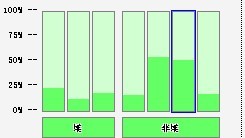Javascript中的重载的实现以及方法apply和call
Javascript中,先定义的函数,可以被后定义的函数覆盖。因此Javascript不支持函数的重载。比如下面的例子:<script type="text/javascript">
function p(a, b, c) {
alert(a+b+c);
}
function p(a, b) {
alert(a+b);
}
p(1,2,3);//alert 6;
</script>
虽然有函数p(a, b, c),但是由于语言的特性,该函数被后面的p(a,b)所覆盖。因此只能调用 function p(a, b)。事实上,javascript中函数的定义可以如下形式:
var p = function (a,b,c) {
alert(a + b + c);
}
var p = function (a, b) {
alert(a + b);
}
这种形式的定义,更直观的看出p被覆盖了。javascript不是纯粹的函数式语言,但是也拥有函数式语言的一些特性,在这里所有的函数都是对象。Javascript语言也不需要编译,因此也无法在编译期间绑定函数。因此javascript调用函数的时候,就直接使用该函数当前的定义。
Javascript语言中,函数的参数可以是不定个数,任何不确定的值都是默认为undifined。比如:
function p(a, b) {
document.writeln(a);
document.writeln(b);
}
调用p(1);会打印出 1 undefined。
因此使用这种方法可以变相的实现重载的功能,如下:
function p() {
if (arguments.length == 2) {
document.writeln(arguments[0]); document.writeln(arguments[1]);
}
if (arguments.length == 3) {
document.writeln(arguments[0]); document.writeln(arguments[1]); document.writeln(arguments[2]);
}
}
p("a", "b");
document.writeln("<br/>");
p("a", "b", "c");
可以看到调用函数p,会根据参数的个数,调用不同的逻辑。这种方式虽然管用,但不够优雅。
使用apply方法,可以有更优雅的写法。
javascript中,函数即对象,因此作为对象,函数也有自己的一些方法,比如toString(), call(), apply()。了解apply方法前,先看一下和它类似的call方法。
call方法的签名如下:
call([thisObj[, arg1[, arg2[, [, argN]]]]])
call方法——代表别的对象调用方法。call方法允许你改变函数对象的上下文,如果参数thisObj 未提供,则默认global对象为thisObj。
具体看一个例子,理解call方法。
var x = 1;
var o = { x: 2 };
function f() {
this.showtime = function () { alert(Date()); }
alert(this.x);
}
f();//先是调用f函数,然后会给global对象定义了一个showtime方法,alert出global的x变量的值。
this.showtime(); //global对象的showtime()已经被定义了,因此可以调用。
f.call(o); //代表o调用call方法,这时候上下文global被改成o对象,因此this.x就是o.x,this.showtime就是o.showtime()
o.showtime(); //o.showtime()已经被定义了,因此可以调用。
call方法可以接参数,表示函数的参数,比如下面的例子
var x = 0;
var o = { x: 2 };
function f(a,b) {
alert(this.x+a+b);
}
f.call(o,3,4); //alert 9
apply方法和call方法相同,除了apply接受的参数是一个数组。
apply([thisObj[,argArray]])
因此上面的方法,改写成apply的话就得如下写:
var x = 0;
var o = { x: 2 };
function f(a,b) {
alert(this.x+a+b);
}
f.apply(o, [3, 4]);
网上有老外写了一套方法,专门实现类似重载的效果。
http://ejohn.org/blog/javascript-method-overloading/源码如下:
<!DOCTYPE HTML PUBLIC "-//W3C//DTD HTML 4.0 Transitional//EN">
<html>
<head>
<title></title>
<script type="text/javascript">
function addMethod(object, name, fn) {
var old = object[name];//闭包
object[name] = function () {
if (fn.length == arguments.length)
return fn.apply(this, arguments);
else if (typeof old == 'function')
return old.apply(this, arguments);
};
}
function Users() {
addMethod(this, "find", function () {
// Find all users...
alert();
});
addMethod(this, "find", function (name) {
// Find a user by name
alert(name);
});
addMethod(this, "find", function (first, last) {
// Find a user by first and last name
alert(first + " " + last);
});
}
var users = new Users();
users.find(); // Finds all
补充:web前端 , JavaScript ,



